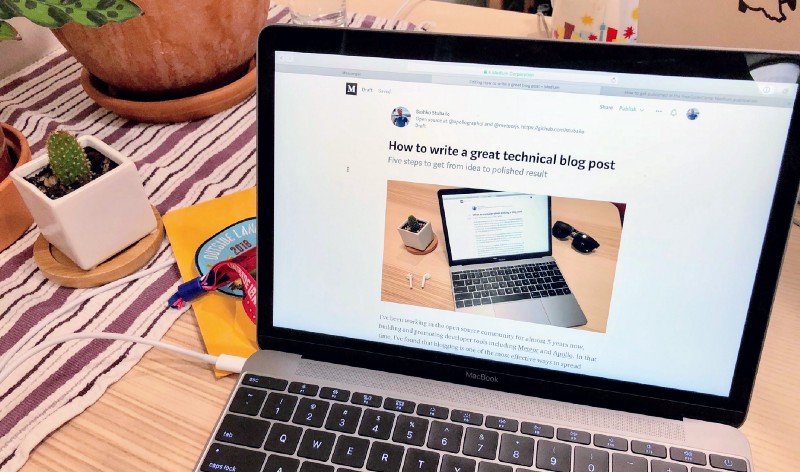How To Write An Educational Blog Post
How to write a great technical blog post

Five steps to get from idea to polished result
I've been working in the open source community for almost 5 years now, building and promoting developer tools including Meteor and Apollo. In that time, I've found that blogging is one of the most effective ways to spread ideas.
A blog post doesn't take as long to prepare as a video or conference talk, but is easy to consume and can reach a ton of people. I've also personally gotten a ton of benefit out of writing: it has helped me organize my thoughts, teach people about technologies I love, and get my name out there.
Since publishing my first blog post ever in 2014, I've ended up writing 68 posts so far here on Medium, some with over 50k views and 1000 fans, and edited many posts for my friends and coworkers. Over that time, I've picked up a few strategies for taking a post from concept to publication.
In this article, we'll go over five main steps of my process for writing a post:
- Find a good topic and commit to it
- Make your goals and audience specific
- Have a beginning, middle, and end
- Get feedback and iterate
- Add finishing touches: packaging, publication, and promotion
Let's get right into the first step!
1. Find a good topic and commit to it
You can't get started on a post unless you have something to write about! When I talk to people who want to start blogging, this is often their main blocker.
The simplest strategy is to write about what you know. If you spent many hours learning about something, and you think you could explain it in just a few minutes, you're going to provide a lot of value to your readers.
Another idea is to write about an area you think is lacking content. For example, right now there aren't a lot of posts about how to apply to technical conferences, so content about that could fill a gap in the community.
Here are some specific types of posts you could go for. Examples are from the GraphQL-related posts on the Apollo blog:
- A step-by-step guide to achieving a specific goal: "Building a great scrollable list in React Native with FlatList" or "Simplify your React components with Apollo and Recompose". These are great for readers that are looking to get in, do a thing, and get out fast.
- An in-depth survey on a particular topic: "Using nullability in GraphQL" or "Anatomy of a GraphQL query". These are useful if you're targeting a more interested audience that wants to grab a cup of coffee and learn a ton.
- A numbered list of useful facts around a common topic: "4 simple ways to call a GraphQL API" or "5 benefits of static GraphQL queries". These are a fun, lightweight read since you don't have to commit to reading the whole thing, and it's easy to consume the bite-sized pieces.
Now, let me dispel a few common concerns:
- There is already content out there about this topic. Don't let that stop you. Even if your idea has been written about before, you can put your own perspective on it, or make it specific to your situation.
- My idea isn't interesting enough. A lot of my friends and coworkers don't end up writing because they are worried their conclusions might be boring or obvious. That's a normal feeling! If you're an expert on something, then of course the conclusions you're writing about will be boring… to you. The key is that people in your audience don't know that stuff yet.
Having said all that, at the end of the day, it's hard to predict what topics will make a great post and which ones won't, and often it's the execution that makes or breaks a post, not a brilliant topic. My main suggestion would be to try writing about several different things and see what works.

2. Make your goals and audience specific
Now that you know your topic, you need an audience and goal for your post. Who will be reading it, and what are they going to get out of it?
Your goal needs to be specific so that you can focus all of your energy on one main idea. For this post, the goal couldn't have just been "write about blogging". I needed a more specific goal in mind:
- Audience: People who want to start blogging, especially about technical topics, but haven't done it yet.
- Goal: Give people a concrete set of steps and pointers so they can get started.
Once you have these, keep your post focused by removing anything that doesn't contribute, and avoid adding extra detail just because it's related. I've found that relatively concise posts with a 5 - 10 minute read time are the most successful.
Knowing the background of your audience will allow you to tailor your writing to their existing knowledge, and can help determine how you should publish and promote your content. For example, I hope to publish this on freeCodeCamp, because a lot of people in my target audience might already read that publication.
3. Have a beginning, middle, and end
It's disorienting when a post veers off in a direction you weren't expecting. Plot twists can be a big benefit in fictional short stories, but it's easier to consume a technical article if you get exactly what you expect. You can keep your readers on track by giving your post a comfortable structure.
Introduction
The first paragraph or two of your post will either convince the reader to stay on or lose their attention. Start off with a little bit of context to help people understand where your post fits into the big picture. Then, tell your audience what they will get out of reading your article. It might be tempting to leave the big reveal for the end, but watch out: if you don't have a good hook, your readers won't stick around to find out.
Middle
Now that you've told your readers what to expect, give it to them! Feel free to go into as much detail as you need, and leave sign-posts along the way to orient people. Use a lot of headings, numbered lists, and formatting to help people understand where they are, and enable them to skip around to the content they are most interested in.
Conclusion
Don't just taper off into the void at the end of the article. If your reader has made it all the way there, they really care. Give them a quick summary of what they learned, a pat on the back for reading, and maybe even something to do next if they're inspired - a call to action.
The format I'm suggesting here isn't the most creative, and there are certainly other ways of doing it. But a simple structure is the most direct way to communicate with your readers.

4. Get feedback and iterate
You won't know what people are going to get from your writing until they read it. This is where your assumptions about your topic, goals, the details of the post, and the structure are really put to the test. If you want to have a good result, you can't skip this step.
It might feel like you're imposing when you ask for feedback, or you might be worried that it will be negative, but people are more willing to help than you expect. It's much better to find out how your post could be better before you publish it to the world. When I was putting together this post, I got some super valuable feedback that made the content much better and more focused.
What should you ask your reviewers? My main advice is to leave it as open-ended as possible. Try not to explain up front what you meant to achieve. Hand over the draft as-is, and ask your reviewer what they got out of it or what should be changed. When someone on the Internet comes across your article, they won't have any extra context and it has to stand on its own.
The main thing to validate from the feedback is: will this post achieve the goals you decided on in step 2? Iterate until you're confident it will.
5. Add finishing touches: packaging, publication, and promotion
Now that you have the idea, the goal, the structure, and some feedback, it's time to polish everything up and ship it.
Packaging
Come up with a great title and subtitle, and make sure your post has at least one image. This is what people will see when the post is shared on Twitter or Facebook, and it's your chance to get people interested in reading.
It's also important that your post looks and feels professional, so that your content can really shine. You should aim to have no spelling errors, grammar mistakes, or weird formatting in your post. If you have a friend that is great at spotting small details, ask them to read it over before publishing.
The freeCodeCamp article about getting published also has some great tips about writing style and formatting. Since you've already put so much work into your post, it's worth it to add that little extra effort to really polish it up and give it a wider reach.
Finally, make sure to credit anyone whose work you referenced, or who helped review and edit your post.
Publication
You're almost there! Pick where you actually publish the post so that it has the best chance of reaching your audience. Medium is generally a great place for technical content, and makes it easy for people to discover your writing.
For bonus points, try to get your post into a relevant publication that will help share your content - in this case, I've selected freeCodeCamp because I think this advice will be relevant to their readers. If you'd like to do the same, here are their directions for submitting your post. Publications in your areas of interest are likely also looking for posts, so don't be afraid to get in touch!
Promotion
Once you've actually published the post, you're not done! If you want people to see what you've written and get value out of it, make sure to share it in the places where your audience is likely to hang out. This might include Facebook groups, Reddit, Hacker News, LinkedIn, or any other platform. Also, make sure to share your creation on your own social media accounts, like Twitter. Your friends will be excited to read, share, and upvote what you've written!
And now, you're done. Go get a coffee or take a walk - taking a blog post from start to finish is no small feat. Read any feedback and replies from the the community so that you can keep improving. And when you have another idea, go do it again!

There's no replacement for practice
We just walked through five of the most important things to do when writing a blog post, from coming up with the idea to publishing. Now that you've read it, you try applying this advice and see what works for you.
I'll leave you with one last bit of advice. The main thing I learned from blogging over the last 3 years is that I absolutely can't predict what content will take off and what will end up being a total dud. Sometimes, I'll put several days into a post, polishing every corner, and it won't go anywhere. On the other hand, "GraphQL vs. REST", my most-read post ever, was written in a few hours late at night.
So even if your first, or second, or third posts don't succeed, keep trying new stuff, putting your ideas out there, and improving over time. The world wants to hear what you've got to say. Go tell them!
Huge thanks to Anvisha Pai, Angela Zhang, Katie Siegel, and the freeCodeCamp editors for helping review this post.
If you read this far, tweet to the author to show them you care. Tweet a thanks
Learn to code for free. freeCodeCamp's open source curriculum has helped more than 40,000 people get jobs as developers. Get started
How To Write An Educational Blog Post
Source: https://www.freecodecamp.org/news/how-to-write-a-great-technical-blog-post-414c414b67f6/
Posted by: tsenggasselve.blogspot.com

0 Response to "How To Write An Educational Blog Post"
Post a Comment